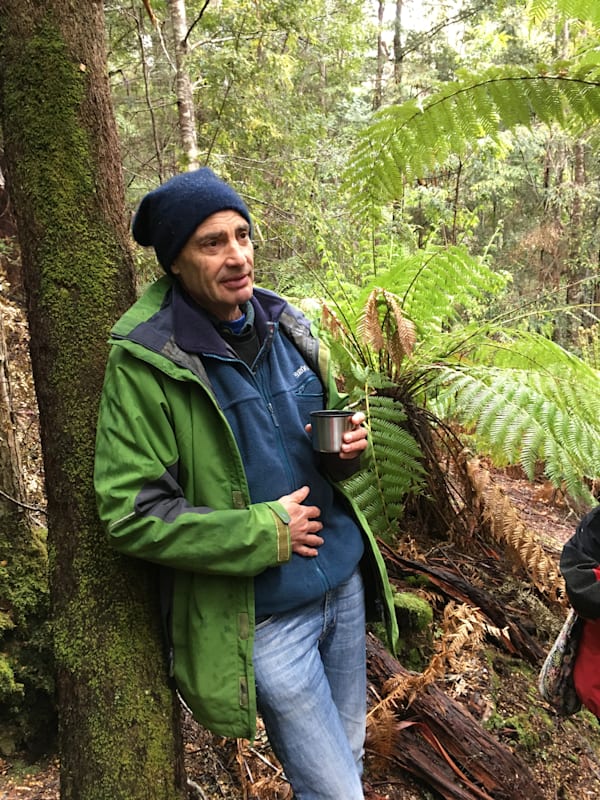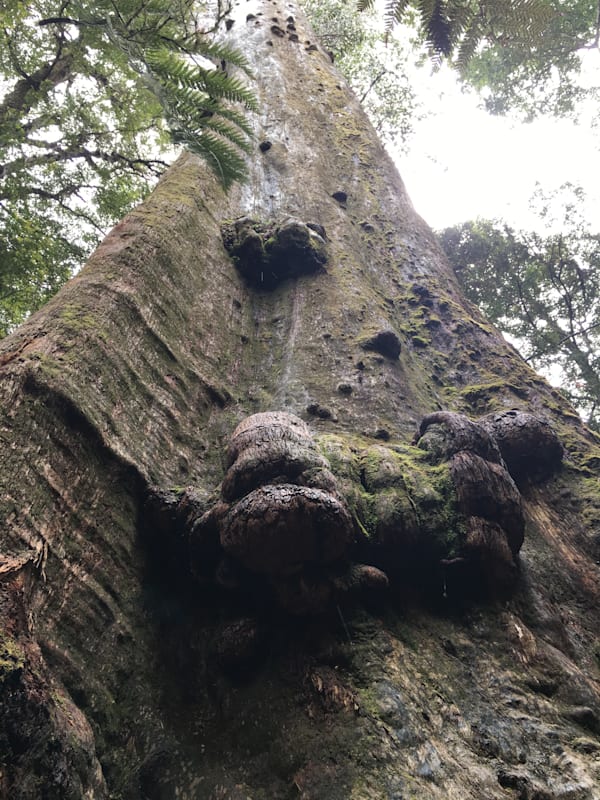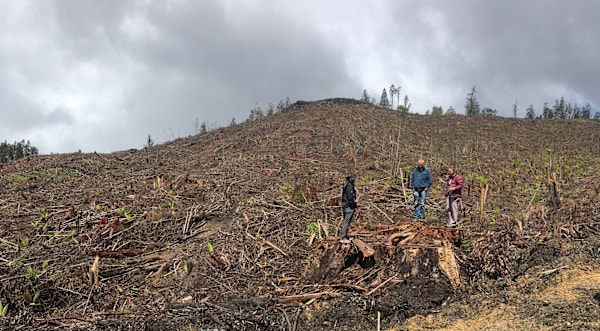Thirty minutes south-west of Tasmania’s Mount Field National Park lies a valley inhabited by giants. Many stand more than 85 metres tall with mottled white-grey arms and spindly fingers pushed skywards. Trousers of bark begin near the waist where a ring of peeling strips forms a tasselled belt. Feet encased in boots of moss and fungi are so wide that six adults could stand with arms outstretched and still only touch fingertips. These are Eucalyptus regnans, until very recently the tallest known flowering trees in the world.
Deep in the Styx Valley, our ragtag group is being guided by Geoff Law, who headed The Wilderness Society (TWS) campaign to prevent this ancient place from being turned into pulp for paper.
Standing on a gravel access road cut in anticipation years ago by the forest industry, the wall of forest seems almost impenetrable to my untrained eye. Law walks confidently to a small gap in the trees and disappears up the muddy slope of the ”Tolkien Track”. Established by TWS at the start of their campaign, the track was an attempt to bring people to the forest and see what could be lost. The only obvious markers along the way are the occasional pink tapes tied to a tree, but Law doesn’t pay attention to these guides. He has walked this path hundreds, if not thousands, of times.
We tramp single-file uphill through stands of sassafras and across spongy layers of moss and fallen myrtle. The day is wet and windy, and we all walk head down, hoods up in a futile attempt to keep our faces dry.

In keeping with its Lord of the Rings theme, the path takes us past the double-trunked Fangorn and through the centre of Cave Tree before reaching Gandalf’s Staff. This mammoth tree is estimated to be at least 350 years old and is so tall that we must crane our necks back to see the topmost branches swaying high above. Measured at 84.5 metres, Gandalf’s Staff was just short of the 85 metres needed to qualify as a ”giant” tree and be protected from logging. (Ironically, the tree was later remeasured and found to be 85 metres).
With scores of similarly sized trees throughout the Styx, Gandalf’s Staff stood as a symbol of the grandeur, beauty and ecological importance of the forest about to be bulldozed. It was here, in late 2003, that protesters from TWS and Greenpeace set up ropes, pulleys and platforms to form a canopy-high ”global rescue station” sit-in.
Battles to protect Tasmania’s forests had been running for decades. Law says that by the early 1990s the media was ”jaded” and “disinterested” in ”another bloody forestry story”.
To cut through this and attract attention, Law and his fellow campaigners needed to be creative in their tactics. The global rescue station near the top of Gandalf’s Staff offered the “sheer drama of having someone 65m up a tree for months on end, effectively putting their lives on the line.” The protesters also converted the tree into a giant Christmas tree complete with decorations, oversize presents, an illuminated star and an abseiling Santa.
The campaign attracted interest, with the likes of musicians John Butler, Jimmy Barnes, Olivia Newton-John and John Williamson coming to the site. A visit by then Federal Opposition Leader Mark Latham in the lead-up to the 2004 federal election, and his subsequent promise to phase out old growth logging, splashed the Styx across national newspapers.

“We thought we were on a roll in 2004,” says Law. ”[Prime Minister] John Howard was talking about saving old growth forests. It was just a question of who was going to save the most.”
However, Howard won the election emphasising the protection of forestry jobs more than the protection of forests and the Styx campaign limped on for almost another decade, side by side with battles to save the Tarkine, Weld and Florentine.
By 2012, both sides were fed up with the ongoing conflicts, and environmentalists and the forest industry sat down to negotiate a truce. The resulting deal, known as the Tasmanian Forest Agreement, led to an extra 170,000 hectares of forest being added to the Tasmanian Wilderness World Heritage Area the following year. This included the tall eucalypts of the Styx Valley, noted in the listing for its “superlative natural phenomena, areas of exceptional natural beauty and aesthetic importance”.
Over the course of a decade, Law witnessed a softening in Tasmanian public opinion around forest issues. Compared to the polarised debates of the 1990s, “there seems to be more consciousness now, a trajectory in the direction of forest protection”, he says. “None of this would have happened without our campaigns.”
It could also be argued that it would not have happened without the drive and imagination of Law himself.
. . .
A bushwalking enthusiast, Geoff Law visited Tasmania several times between 1975 and 1981, walking the Overland Track and zip-lining over the Franklin River en route to Frenchmans Cap. These visits eventually culminated in Law rafting the Franklin itself in early 1981, an adventure he describes as both “terrifying” and “challenging”.
“It was apparent that this was a very integral part of Tasmania’s wilderness and that that whole landscape would be irreparably damaged if that dam went ahead,” he says.
Law threw himself into the campaign to protect the Franklin, becoming the spokesperson for the Franklin Blockade in the summer of 1982-83. He has since become a prominent figure in most, if not all, of the major battles to protect Tasmania’s forests.
At the start of the Styx era, Law was one of the most experienced forest campaigners in Tasmania. This experience had taught him that, “with most environmental victories, there’s usually a sting in the tail.” He asserts that once one area is successfully protected, there is a tendency for compensation to be given to the forest industry or for new areas to be opened for logging.
"That was something I found particularly heartbreaking. But you just kind of had to live with that and hope and work towards getting the politics to a point where you would protect more than the Styx. But it didn't always happen."
Despite these frustrations, Law says he felt energised during most of the Styx campaign. “From 1998 to about 2001, I spent just about every weekend in the forests, either in the Styx or in another threatened forest, and it was very rewarding to be finding giant trees, caves, eagles nests, things that would hold up the progress of the chainsaws. We gained patches of forests here and patches of forest there that forced the logging industry back to the drawing board.”

However, by the time they were decorating the Styx Christmas Tree in 2003, Law admits that he was starting to get tired. This was not helped by the challenges of the next few years, including a four-year legal battle as part of the ”Gunns 20”.
Eventually, Law resigned as TWS campaign manager in 2008, freeing up time to publish a book and take up a Churchill Fellowship examining world heritage areas in the northern hemisphere. Law has never completely left Tasmanian forest campaigns, however, and continues to work with TWS and other environmental organisations in a lower-profile capacity.
For a career protecting Tasmania’s forests, Law received the Order of Australia in 2013.
. . .
As we push wet branches aside, parts of Australia face catastrophic bushfire danger. The same can hardly be imagined on this day in this green oasis – despite more than 95,000 hectares, or 6 per cent, of the Tasmanian Wilderness World Heritage Area had been devastated by bushfire earlier this year. In a warming climate it’s a sobering thought.
The rain and wind that has teased all morning picks up and we begin to worry about the swaying, creaking branches above us. A flock of black cockatoos flies over, screeching noisily as if warning us of the potential danger. It is time to leave the forest. As we file past the giant foot of Gandalf’s Staff, many in our group reach out and pat the rough bark one last time, a silent prayer that our new friend will stay safe.

Driving away from the Valley of Giants, we retrace the gravel forestry road and it is soon clear that we have re-entered forests that are still harvested. Hills stretching ahead of us are shaved of everything, the smaller branches left broken in the dirt. We had seen these slopes -when we drove through earlier in the day, but the destruction strikes us more now after our immersion in the forest. This time we stop to take it in, and Law wanders over to a large stump, felled a metre from the ground. As he climbs onto it, we realize its size. The base of this tree would rival Gandalf’s Staff for width, and we can only assume that when standing it would have towered above its neighbours.
Taking all this in, Law’s words on why forests are important come to mind. "It’s climate, it’s biodiversity, it’s recreation, it’s spiritual renewal for the human species, just to maintain that contact with the natural world that helps keep people sane. All of those arguments apply even more today than they did 30, 40, 50 years ago as there is now so much less of the natural world left.”
We can only be thankful that the giants of the Styx remain.
Grace Heathcote is a Tasmanian freelance writer. After a childhood spent exploring the forests and beaches of Tasmania, she left the island in 2007 to study, work, and travel through Australia and overseas. The charm of Tasmania lured her home in 2014 and has continued to weave its magic for her ever since.







